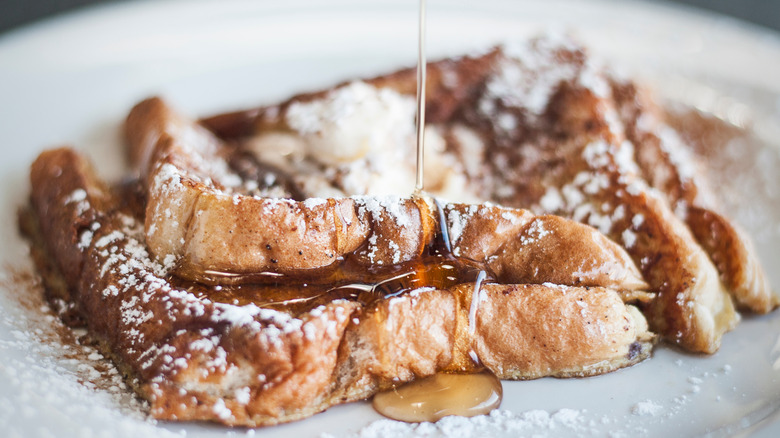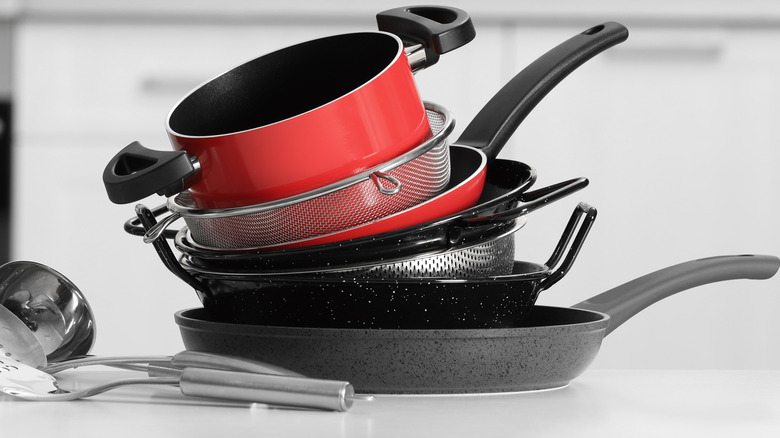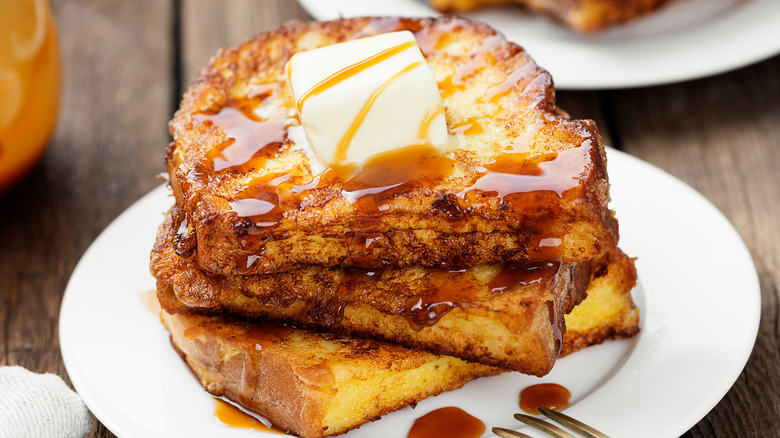The Best Ways To Prevent French Toast From Sticking To Your Pan
Whether you're in favor of a sweet or savory breakfast, most brunch connoisseurs will agree: French toast is a morning must. Practically dessert-for-breakfast, this popular dish is as easy to make at home as it is to find on a menu. With a slew of recipe variations that range from simple to creative, even the most novice of chefs can perfect this decadent treat.
But while French toast bread preferences may vary from classic American to fluffy brioche to leftover holiday panettone, nobody wants a burnt meal. Some foods, like eggs, find microscopic gaps in and form protein bonds with a pan's surface, making them more likely to stick and burn according to The Washington Post. Thanks to its gooey egg coating, French toast is especially inclined to stick to the pan, resulting in a blackened exterior and the dreaded uncooked center. Scraping charred French toast bits off your pan is never fun, either.
To protect your next breakfast and achieve a golden crust, you don't need restaurant-quality ingredients or even high-tech cooking products. With a few easy changes, you'll be able to flip your French toast right off the pan, just in time to top it with your choice of ice cream, Nutella, or your favorite fruit.
Choose the right pan
Using the right pan is a seemingly simple (but effective!) trick to mastering your next French toast morning. Yet knowing which pan to use for delicate foods can be challenging, given the sheer number of available options. For French toast, it's best to stick with something that doesn't stick — literally. Depending on your budget, nonstick pans range from lightweight aluminum to durable diamond coatings, but you don't need to splurge for results. With a basic nonstick pan it'll be easy to get cooking the moment you have a craving.
Once you choose your vessel, it's important to remember the golden rule of cooking with a nonstick pan: Never use high heat. According to Food & Wine, high cooking temperatures can ruin the coating on a nonstick pan, releasing dangerous chemicals into the air and reducing the pan's lifespan. Be sure to keep your pan on low or medium heat, which will not only protect the coating but also your breakfast. We'd recommend cooking each piece at medium heat for roughly two to three minutes on either side for the perfect French toast.
Opt for oil and butter — and don't skimp
Butter is a popular French toast topping, best enjoyed beneath a generous drizzle of your favorite real maple syrup. But don't let fat be a mere afterthought; butter has a multitude of uses and is just as essential in the cooking stage as it is during those first few bites. Once your pan is preheated, bypass the cooking spray, which is more likely to stick to the edges and make clean-up a hassle according to Southern Living. Instead, coat an already-warmed pan with a generous portion of butter. As for how to time the butter with the heat, "you want that butter to sort of sizzle as it goes on, but not instantly burn," says food writer and chef J. Kenji López-Alt. But while López-Alt exclusively uses butter in his French toast video, Kitchn recommends integrating butter and a neutral oil to limit smoking and sticking. Butter adds flavor and fat, while vegetable oil is perfect for seamless frying.
And make sure to keep the two coming. Depending on the size of your pan — and the length of your loaf — it may be impractical to cook multiple pieces of French toast simultaneously. By coating the pan with butter and oil after each slice, you'll limit the potential for burning and maintain consistency between pieces. Plus, the clean-up will be easy, freeing you to spend the rest of your morning digesting.


